Archive Record
Images
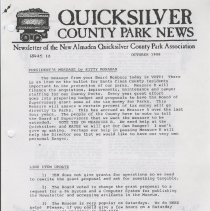
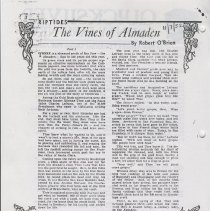
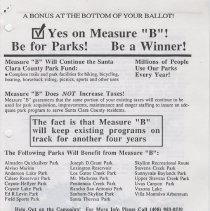

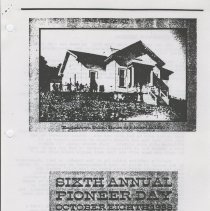
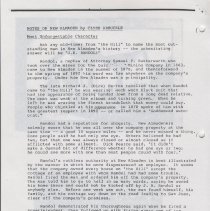
Additional Images [6]
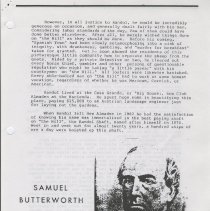


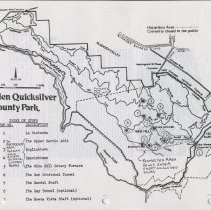
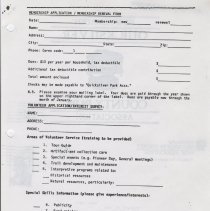
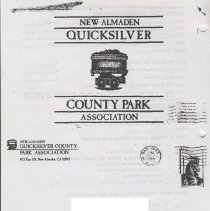
Metadata
Catalog number |
1997.2.2591 |
Object Name |
Newsletter |
Date |
1988 |
Description |
TITLE: Quicksilver County Park News SUBTITLE: Newsletter of the New Almaden Quicksilver County Park Association Issue # 18 October 1988 QUICKSILVER COUNTY PARK NEWS Newsletter of the New Almaden Quicksilver County Park Association Issue 18 OCTOBER 1988 PRESIDENT'S MESSAGE by KITTY MONAHAN The message from your Board Members today is VOTE! There is an item on the ballot for Santa Clara County residents important to the protection of our parks. Measure B will finance the acquisition, improvements, maintenance and ranger staffing for our County Parks. Every year great effort goes into preparing budget and proposals to have the Board of Supervisors grant some of the tax money for Parks. This Measure will assure a certain percent of tax money will go directly to Parks. This has accrued as Measure A over the last four years. The people of the County have to vote to tell the Board of Supervisors that we want the measure to be extended. VOTE YES ON MEAUSURE B. We need help at the Quicksilver and MAYBE we will get Our Own Ranger! I won't give up asking. Perhaps our help in passing Measure B will help the Director see that we would like to have our very own personal Ranger. LINE ITEM UPDATE 1) IBM does not give grants for operations so we need to rewrite the grant proposal and ask for something tangible. 2) The Board voted to change the grant proposal to a request for a PA System and a Computer System for publishing the Newsletter and accessing artifacts in the Museum. 3) The Museum is very popular on Saturdays. We do NEED help! Please, if you could give a few hours on a Saturday afternoon, call Virginia at 269-6068. 4) The Cracker Barrel Meeting was a terrific success. About 150 people attended and the information was timely. 5) From the money we received from dues, donations and tours we gave during the summer, we were able to put on a magnificent Pioneer Days -- feeding 150 people. Looks like Pioneer Day is here to stay -- free and fun. 6) Dames and Moore Geological Firm is hard at work spending $235,000, solving our toxic problem which we do not have! So far no report!!! RIPTIDES___ The Vines of Almaden By Robert O'Brien Part l THERE is a vineyard south of San Jose-theAlmaden-that is 100 years old this year. Its green vines and its purple grapes represent an effective commentary on the California pageant, one more reminder that when the gold was gone from the foothills, the rich earth of the valleys held, after all, the more lasting wealth and the more enduring values. So put them side by side-the caved-In mine shafts and the Mother Lode ghost towns, and the vineyard that the valley earth, the sun, the rain and man's toil have kept alive for a century-and there, in the contrast, is not all, but part of the story of California . . . Among the Gold Rush adventurers were the Bordeaux farmer Etienne Thee and the Passy tailor Charles Lefranc, two of the 20,000 Frenchmen who came to California seeking their fortunes: For a year or two, their histories are lost in the turmoil and the confusion. Like the rest, they must have taken their fling at the mines; like the wiser, they must soon have seen that the Forty-niner's lot - and his chances of striking it rich - had been overrated. Thee knew what he wanted to do, and it wasn't to lead a miner's life. Most of his days had been spent, not in looting the earth, but in plowing and cultivating it, and reaping the harvests that rewarded his toll and care. He left the foothill mining camps for San Francisco, then journeyed south past the bay to the valley of Santa Clara. Coming upon the valley acres by Guadalupe creek, a little south of San Jose and not far from the Almaden road, Thee knew that here was the gold field he sought.. Here, in this Eden that was walled cut the west by the blue Santa Cruz mountains and on the cast by the Diablo hills. he would plant his land and reap his crops. It was Rancho San Juan Bautista land, owned by Jose Agustin Narvaez, the Guadalajara pioneer who had been one of the first settlers of Branciforte, west on the coast. Thee bargained shrewdly with Narvaez and got what he wanted: 300 of those acre:, along the creek and with a knoll, set back from the creek, for the house that he would build. Then he sent to Bordeaux for his family, and settled down for life. The next year was 1831, and Charles Lefranc went to the valley south of San Jose and visited Thee. The land and the life In the Santa Clara sunshine :;,, what Lefranc wanted, too. The Frenchmen became friends, and then partners. Mustard and Narvaez' grain gave way to provincial rows of produce and young fruit trees. From a mission vineyard, Thee obtained some cuttings and planted them near the frame house that he was building on his knoll.The ambitious and imaginative Lefranc watched the grapes ripen. Never, since leaving France, had . he seen larger or lusher grapes. "Would finer grapes grow here like this?" he asked Thee. The farmer smiled. "In this valley, anything would grow." "Let's plant better grapes, then. Wine grapes-from France:" "Wine grapes?" thee shook his head. "You cannot make fine wines here today, and sell them. Anchored In San Francisco Bay, deserted by crews that have gone to the mines, are three or four French ships whose holds are filled with casks of wine. Today, in San Francisco, it is cheaper than water." "But we won't use them for wine," Lefranc replied. "We'll sell them as table grapes. The people here need fruit." This was true, and Thee knew it. The deteriorating mission orchards fell far short of supplying the demand, and, with the State still in the grip of the gold fever, hardly a man was standing still long enough to plant a tree, let alone wait for a crop to grow. "Very well;" said Thee "we will plant more grapes." Without delay, they sent to France for the best vine cuttings of the hills and plains of Burgundy and Champagne and the country of the Rhone. And, in the months that passed before their arrival, the partners traveled south to Los Angeles and north to the Sonoma and Napa valleys for the best California cuttings that they could find, and brought them back to the 300 acres by Guadalupe creek. There. In the spring of 1852, Thee and Lefranc planted them and began the vineyard that is known today, a century later, as the Almaden. The holiday season will soon be here. Be sure to mail overseas packages early! Save a trip to the post office! Use our "STAMPS BY MAIL" forms available at the New Almaden Post Office. Call 268-7730. Agnes Yuseff Postmaster A BONUS AT THE BOTTOM OF YOUR BALLOT! Yes on Measure "B" ! Be for Parks! Be a Winner! Measure "B" Will Continue the Santa Clara County Park Fund: Complete trails and park facilities for hiking, bicycling, boating, horseback riding, picnics, sports and other uses Millions of People Use Our Parks Every Year! Measure "B" Does NOT Increase Taxes! Measure "B" guarantees that the same portion of your existing taxes will continue to be used for park acquisition, improvements, maintenance and ranger staffing to insure an ade-quate park program to serve Santa Clara County residents. The fact is that Measure "B" Will keep existing programs on track for another four years The Following Parks Will Benefit from Measure "B": Almaden Quicksilver Park Alviso Marina Anderson Lake Park Calero Reservoir Park Coyote-Hellyer Park Coyote Lake Park Ed R. Levin Park Field Sports Park Joseph D. Grant Park Lexington Reservoir Los Gatos Creek Park Mt. Madonna Park Penitencia Creek Park Rancho San Antonio Park Sanborn-Skyline Park Santa Theresa Park Skyline Recreational Route Stevens Creek Park Sunnyvale Baylands Park Upper Stevens Creek Park Uvas Canyon Park Vasona Lake Villa Montalvo Arboretum. Help Out on the Campaign! For More Info Please Call (408) 983-0539 PARKS/) YES on B"; 960 W Hedding, San Jose CA 95126 Aurelia Winsemius, Treasurer I.D. #862-140 PIONEER DAY 1.988 by AGNES YUSEFF Pioneer Day -- October 8 -- highlighted "Back to School" honoring the memory of our Englishtown School House On Mine Hill. We were transported To Mine Hill by a van lent for the day by the St. Anthony Parish, driven by Mike and Sandy Furnish and the thrilling rides in various trucks. Sparkling October weather, coupled with the warmth of friendships, as over one hundred friends and neighbors enjoyed the delicious barbequed chicken and extras prepared by Nancy and Dutch Mapes. Tables, decorated by Peggy Melbourne, carried out the theme of the day with schoolhouse centerpieces --complete even to the red apple for the teacher! Souvenir programs pictured the schoolhouse and keepsake square nails from the original building. Speakers reminisced about mining days. Frank Kambish and Steve Saunders, Superintendent of Almaden Schools, told interesting incidents. Norman Pope's story of the moving of the schoolhouse drinking fountain to the grounds of the Randol School was read by his son, Greg Pope. Friedolin Kessler and Don N:eden shared their memories of the past while Michael Cox shed light on future prospects for Quicksilver County Park's resource center. Constance Perham introduced honored visitors -- the Delaato Family -- who are direct descendants of Andre Castillero. Father Bob Hayes completed the program by blessing the site of the schoolhouse and everyone present. We were indeed blessed! All who attended owe thanks to Kitty Monahan and Virginia Hammerness and their hard working committee who made our sixth annual Pioneer Day an, outstanding success. We can hardly wait for next year! NOTES ON NEW-ALMADEN by CLYDE ARBUCKLE Most Unforgettable Character Ask any old-timer from "the Hill" to name the most outstanding man in New Almaden's history -- the unhesitating answer will be "J.B. RANDOL!" Randol, a nephew of Attorney Samuel F. Butterworth who took over the mines for the Quicksilver Mining Company in 1863, came to New Almaden in the summer of 1870, and thenceforward to the spring of 1892 his word was law anywhere on the company's property. Under him New Almaden was a principality. The late Richard J. (Dick) Pearce recalled that when Randol came to "the Hill" he was wearing a much worn black suit that had the appearance of being handed down from a long dead relative. The coat was weak at the elbows and turning green. When he left he was wearing the finest broadcloth that money could buy. People who chuckled at his appearance in 1870 spoke of him with the greatest respect in 1890 -- or called him a "Goddamned autocrat." Randol had a reputation for ubiquity. New Almadeners solemnly swore that he was all over the company property at the same time -- a good 10 square miles -- and he never missed a thing., Some people said he had only one eye. Others believed he had two, but that one was always closed or almost closed as if afflicted with some ailment. Dick Pearce said, "It didn't make a damned bit of difference whether he had one eye or two; he could see more with one than most people could with four." Randol's ruthless authority at New Almaden is best illustrated by the manner in which he once dispossessed an employee. It seems that the company owned every house on "the Hill" except the cottage of an employee with whom Randol had had some trouble. Randol fired the man and ordered him off the company's property. The man told him to go to hell in as many words, saying he owned his home there and could not be kicked off by J. B. Randol or anybody else. Before one week was out, the man found himself, his family, and his cottage way down on the road leading to San Jose, clear off the company's premises. Randol demonstrated his thoroughness again when he fired a superintendent, then followed up with firing every one of cue man's relations, no matter how remote, and evicting them from "the Hill." This cost the Quicksilver Mining Company a con-siderable number of employees, for the man was a "Cousin Jack", with the Lord knows how many aunts, uncles, cousins, brother- and sisters-in-law living in "English Town" with him. However, in all justice to Randol, he could be incredibly generous on occasion, and generally dealt fairly with his men. Considering labor standards of the day, few of them could have done better elsewhere. After all, he merely wished things done on "the Hill" as they should be done. Before his coming, "Spanish Town" had been slowly metamorphosing into a sink of iniquity, with drunkeness, gambling, and "murder for breakfast" taken for granted. But h-:: soon showed the residents of this picturesque little community how to separate the sheep from the goats. Aided by a private detective or two, he cleared out every horse thief, gambler and other persons of questionable reputation who might be taking "a little pasear" with his countrymen on "the Hill." All loafers were likewise banished. Every able-bodied man on "the Hill" had to work at some honest vocation, regardless of whether he was Mexican, Cornish, or American. Randol lived at the Casa Grande, or "Big House:, now Club Almaden at the Hacienda. He spent huge sums in beautifying this place, paying $25,000 to an Austrian landscape engineer just for laying out the gardens. When Randol left New Almaden in 1982 he had the satisfaction of knowing his name was immortalized in the best paying shaft on "the Hill", the Randol Shaft, named after himself in 1870. Week in and week out for almost twenty years, a hundred skips of ore a day were hoisted up this shaft. SAMUEL BUTTERWORTH HISTORICAL REPORT Did you know that New Almaden was included in a report by Colonel R. B. Mason to President Polk about the gold riches in California? It was dated August 17, 1848 and was read to Congress and is in the Congressional Record. It stated: -,Before leaving the subject of mines, I will mention that on my return from the Sacramento I touched at New Almoden(his spelling), the quicksilver mine of Mr. Alexander Forbes, consul of her Britannic Majesty at Tepic. This mine is a spur of mountains 1,000 feet above the level of the bay of San Francisco, and is distant in a southern direction from the Pueblo San Jose about twelve miles. The ore (cinnabar) occurs in a large vein dipping at a strong angle to the horizon. Mexican miners are employed in working it, by driving shafts and galleries about six feet by seven, following the vein. The fragments of rock and ore are removed on the backs of Indians in raw-hide sacks. The ore is then hauled in ox wagon from the mouth of the mine down to a valley well supplied with wood and water, in which the furnaces are situated. These furnaces are of the simplest construction, exactly like a common bake oven, in the crown of which is inserted a whaler's trying kettle; another inverted kettle forms the lid. From a hole in the lid a small brick channel leads to an apartment or chamber, in the bottom of which is inserted a small iron kettle. This chamber has a chimney. In the morning of each day the kettles are filled with mineral, (broken in small pieces) mixed with lime; fire is then applied, and kept up all day. The mercury, volatilized, passes into the chamber, is condensed on the sides and bottom of the chamber, and flows into the pot prepared for it. No water is used to condense the mercury. During a visit I made last spring, four such ovens were in operation, and yielded in the two days I was there 656 pounds of quicksilver, worth at Mazatlan $1.80 per Is. Mr Walkinshaw, the gentleman now in charge of this mine, tells me that the vein is improving, and that he can afford to keep his people employed even in these extraordinary times. This mine is very valuable of itself, and becomes the more so, as mercury is extensively used in obtaining gold. It is not at present used in California for that purpose, but will be at some future time. When I was at this mine last spring, other parties -ere engaged in searching for veins; but none have been discovered that are worth following up, although the earth in that whole range of hills is highly discolored, indicating the presence of this ore. I send several beautiful specimens, properly labelled. The amount of quicksilver in Mr. Forbes's vats on the 15th of July was about 25,000 pounds." 112 DE ARGENTO VIVO ENTRANCE TO THE PRINCIPAL MINE . . . The Almaden mine, from which the largest amount of ore has been obtained, is situated near the summit of a hill, and is distant about a mile and a half from the Reduction Works. In this occurs the great Ardilla "labor"-the largest deposit of cinnabar aver found in California, and probably the largest in the world. Owing to the difficulty of blasting the hard rock at a great depth from the surface, explorations haw been recently made which have resulted in the discovery of large bodies of ore in the soft ground on the slopes of the hill. A new and extensive tunnel now taps some of the richest veins ever found in this mine, and its productions have largely increased. The Cora-Blanca, a thousand yards easterly from the Almaden, has recently been discovered and prospected, and the results are highly encouraging. The Road Tunnel and the San Juan are producing extremely rich ores; and the Buena Vista, which is 2820 feet in length, has been extensively worked with very fine results. The San Francisco, another tunnel, has developed immense quantities of ore; and the Velasquez is regarded as one of the most promising in the Company's possessions. . The America, or Bull Run, commenced in 1863, has developed immense cinnabar deposits, which alone would constitute a vast and inexhaustible mine. In this the vein is regular and well-defined, the ores rich, and the general indications most promising; but the great abundance of rich metal in other mines easier of access has roused the America to be but little worked. In addition to these there are in the Arroyo de los Capitancillos, which runs northwesterly from the elevated point upon which the America is situated, a series of valuable mines worked by the old company, comprising many rich veins, among which may be named the Providencia, the Enriqueta, the San Antonio, and La Purissima. Furnaces and reduction works were established many years ago near the center of these mines; but owing to the development of new leads in closer proximity to the principal hacienda, they have not been used to any extent during the past few years; and the mines are now only partially worked with a view of keeping them in good condition. The Enriquita alone has produced about a million three hundred thousand pounds of quicksilver, and is considered one of the most valuable mines on the great cinnabar range. It will thus be seen that there is no probability, and scarcely a possibility of any deficiency of ores. The policy seems to be, as in other kinds of mining, to work only where the ores can be most conveniently and abundantly obtained, proximity to the reduction works being an important consideration . . . . From Down in the Cinnabar Mines, by J. Ross Browns UNUSUAL EVENTS by NORM POPE About my daughter, Debby. She worked for IBM for several years. (Retired due to ill health). In her department there was a man named Ralph Butterworth. One day he brought a box filled with old photographs and letters, telling his co-workers these were old family photos and letters they might be interested in. He told Debby these were photos and letters of his ancestors but he didn't know much about them. Debby recognized some of. the photos that were in her book "Cinnabar Hills". She told Butterworth this and promised to bring her book to work. Butterworth was elated. He found out about his antecedents and carried it further by joining the San Jose Historical Society. |
People |
Arbuckle, Clyde Butterworth, Samuel Fowler Castillero, Andres Cox, Michael Hayes, Bob (Father Hayes) Kambish, Frank A. Kessler, Friedolin Lefranc, Charles Mapes, Dutch (Warren J.) Melbourne, Peggy Monahan, Kitty O'Brien, Robert Pearce, Richard James Pope, Norman Pope, Norman Saunders, Stephen Wells Thee, Etienne Weden, Don Yuseff, Agnes |
Cataloged by |
Meyer, Bob |
